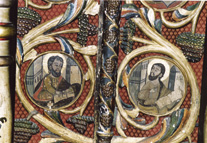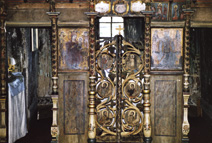The people of Reghin
call their community the “Town of Violins,” a quintessential name for a
truly beautiful municipality. The Town of Violins is situated in the
vicinity of Bistriţa, Cluj-Napoca or Topliţa, thirty-two kilometres from
Tîrgu-Mureş at the place where the Mureş and Gurghiu rivers converge as
they flow down from the Călimanului and Gurghiului mountains.
A
SHORT HISTORY OF THE MICHAEL AND GABRIEL PATROL ANGELS CHURCH
Documentation from the year 1228 indicates that the
town was originally incorporated during the reign of Saint Louis,
sometime between the years 1077 and 1095 A.D, using the name ‘Saxon-Reghin.’
The earliest population was of Saxon-German descent. However, an influx
of Hungarian and Romanian workers to the region increased the size of
the town significantly as these newcomers settled on the outskirts of
the municipality in areas that came to be known as “The Maiers.” It was
here, at the margins of the newfound settlements that the Romanian
population of Reghin built a small church for themselves in 1725.
They named their new building the, “Michael and Gabriel Patrol Angels
Church.” The Romanians were assisted in this endeavour by a group of
merchants from Macedonia. One can clearly see Macedonian influence in
the construction and style of the Michael and Gabriel Patrol Angels
Church, which is markedly different from that of other Romanian churches
of the same period. The layout is in the shape of a cross, a typical
Macedonian “Tri-conical’ plan. The construction is of pinewood joists
with an oak-wood sleeper. There is no plaster coating over the exterior
wooden structure. The roof is comprised of a single, shingled unit. The
original church did not have a porch, tower, or bell but in 1791, Petru
Maior, the scholarly Dean who was serving as Parish Priest at that time,
had a portico and bell-tower constructed, additions that survive to this
day.
The interior of the church consists of a vaulted nave that measures ten
metres by six metres. The ribs of the vault terminate in the form of the
arched apse. Each apse is three metres by two metres in size. There is a
polygonal altar built across the width of the nave. The altar is a
seven-sided structure with the north and south perimeters running
parallel and built wider than the other sides, resulting in a spacious
interior. The inclusive dimension of the altar is four metres by four
metres. The joints of the altar and the apses are carved with the
greatest of artistry by anonymous joiners and woodworking craftsmen.
|
-
Toader Zugravul, an
artist working in the Reghin vicinity and thereabouts in 1789, painted
the artworks on the altar of the Church. His paintings are done directly
on the wood, with the decoration extending over the whole surface of the
altar, a style designated by Orthodox religious imperatives. It appears
from the design of the artwork that Toader Zugravul was in direct
contact with Áyion Óros, the ‘Holy Mountain,’ also known as Mount Athos,
situated in northern Greece and where an autonomous theocracy of the
Greek Orthodox faith flourished during this era. There are also artworks
done by Toader Zugravul above the doors of the church temple, the
so-called fourteen ‘praznicars,’ or masterpieces. On the back of one of
these icons is the original signature of this great painter. Since 1789,
the church has been renovated several times and the temple, were the
church’s patrimonial objects are kept, contains several royal icons that
date from later epochs.
Reference to the early history of the Church is cursory, stating only
that, “Anonymous abbots have served the church,” thus the names of those
who served prior to Petru Maior are unknown. Names of subsequent parish
priests are: Pamfil, who served the parish for forty years; Basil the
Great, functionary for thirty years; and Petru Ciobotaru, who was parish
priest for forty years. Basil the Great and Petru Ciobotaru are buried
near the church. In 1848 the parish as such ceased to exist and the
church became an affiliate of the 2nd Parish of Reghin, headed by Priest
Pop Gheorghe. Since then, the Priest Ioan Oprinca served the church
until 1940 and Priest Iuliu Man was formally in charge until 1948.
Some renovations of the building were undertaken in 1980. The roof was
given new shingles, while the cupola and floor were refurbished. The
Parish was reestablished in 1985 and it was at this time that the name
of the church was changed to “Petru Maior,” out of well-deserved respect
for this great scholar, priest, and servant of the church. The
re-endowment of the Parish and the changing of the name became a crucial
moment in the life of this church and the Petru Maior Church has come to
represent a valued part of the national heritage of the Orthodox culture
of Romania, as well as a renowned artistic monument. Each year it is
visited by hundreds of tourists from many countries in the world.
Today the ‘Petru Maior Parish’ flourishes under the attentive direction
of Priest Ilie Damian who takes good care of the church, recognizing
that it is an eminent historical monument of his country. However it is
exigent to note that because the structure is made of wood and due to
the fact that the church was neglected for such a long time, there is a
need for major reparations. The necessary documents have been drafted
and submitted to the official authorities asking that the church be
declared a “Museum,” and that the shingled roof be repaired, work that
is urgently needed. As part of this declaration, the patrimonial objects
in the building would be donated to the Mureş County Museum.
Reghin, the 1st of September 2002
Ilie Damian,
Parish Priest
|



